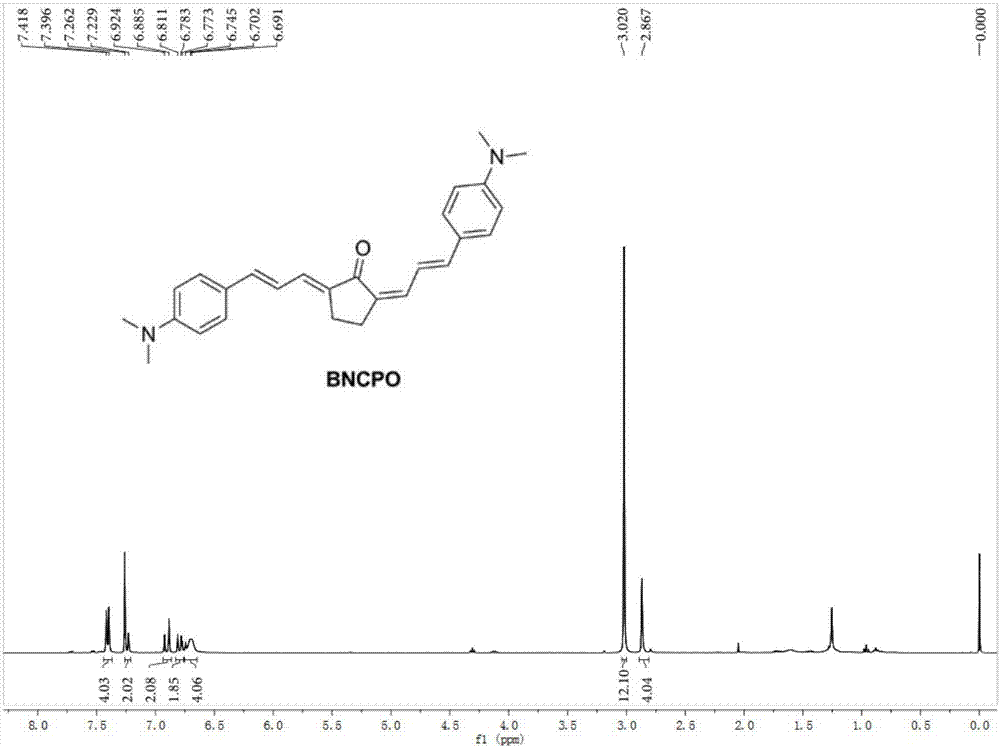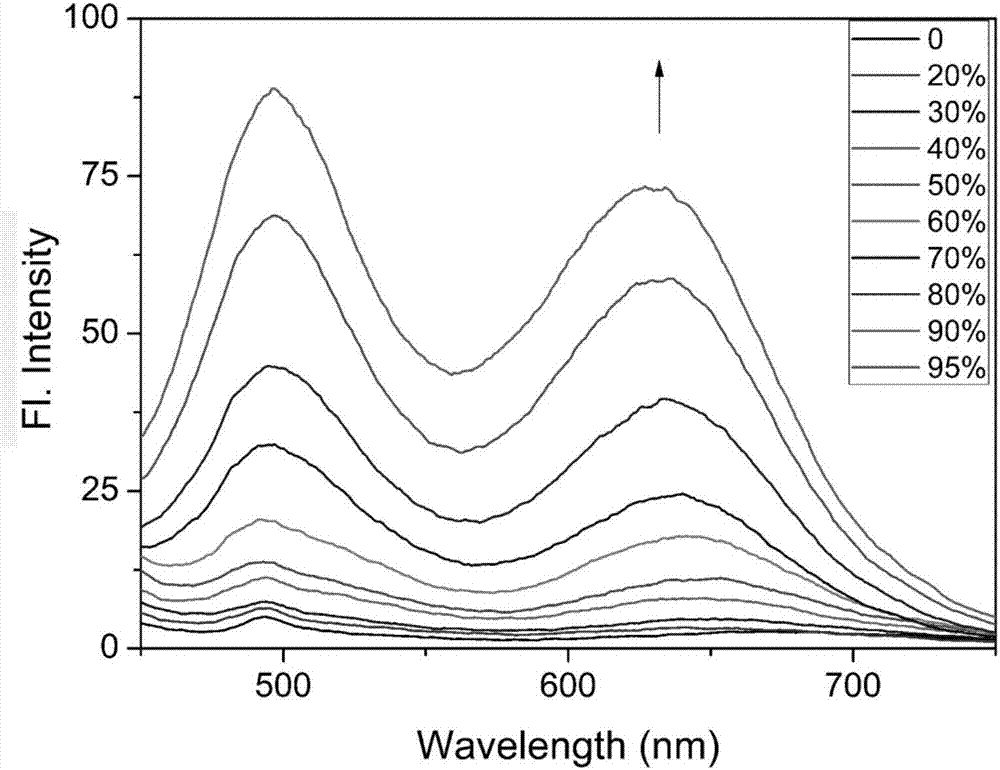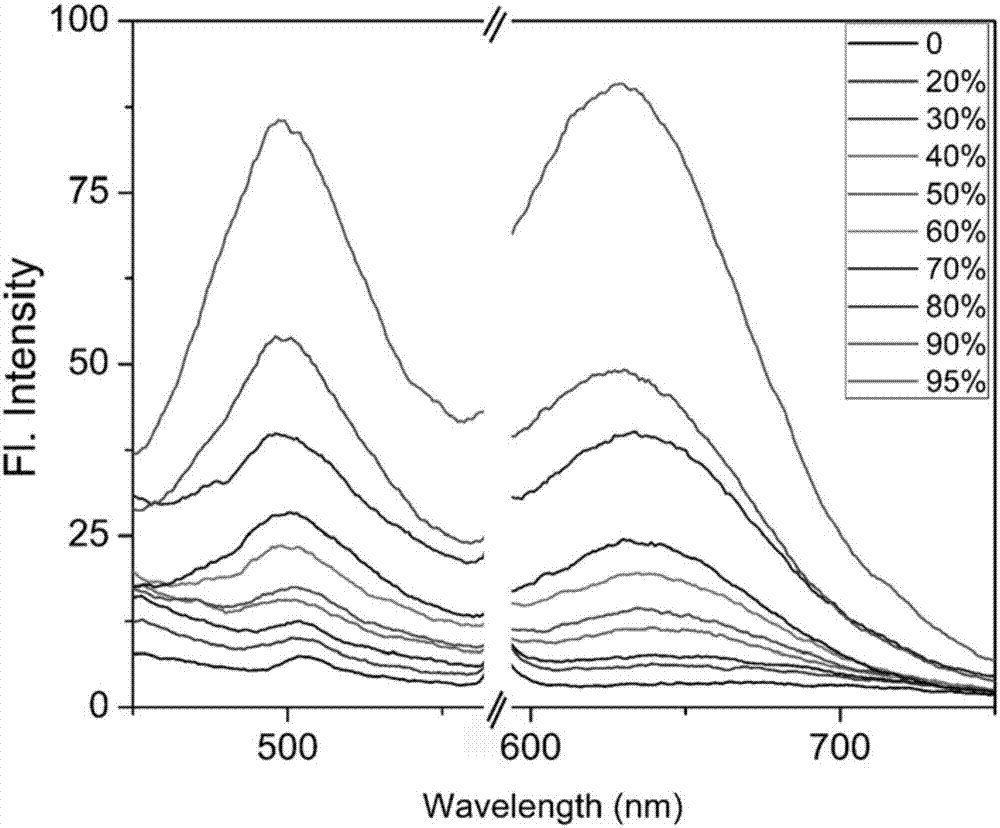Cell viscosity fluorescence probe and preparation and application of cell viscosity fluorescence probe
A fluorescent probe and viscosity technology, applied in fluorescence/phosphorescence, preparation of organic compounds, luminescent materials, etc., can solve problems such as unreported, and achieve the effects of low cytotoxicity, broad application prospects, and simple synthesis methods
- Summary
- Abstract
- Description
- Claims
- Application Information
AI Technical Summary
Problems solved by technology
Method used
Image
Examples
Embodiment 1
[0024] Example 1 Synthesis of fluorescent probe BNCPO.
[0025] Dissolve 1 mmol of cyclopentanone in 15 mL of absolute ethanol, add a small amount of solid NaOH, and stir the reaction solution at room temperature until NaOH is completely dissolved. Then, 2 mmol of 4-dimethylaminophenylacrolein was added into the above reactor, stirred at room temperature under a nitrogen atmosphere, and the end of the reaction was detected by TLC. During the reaction process, a red precipitate gradually precipitated and was filtered with suction to obtain a crude product. Recrystallized once from absolute ethanol to obtain the red probe BNCPO with a yield of 81%. 1 H NMR (400 MHz, CDCl 3 ): δ = 7.41 (d, J = 8.8 Hz, 4H), 7.23-7.26 (m, 2H), 6.90 (d, J = 15.6 Hz, 2H), 6.81-6.77 (m,2H), 6.75-6.69 (m, 4H), 3.02 (s, 12H), 2.87 (s, 4H). HRMS: m / z [M+H] + calcdfor [C 27 h 31 N 2 O] + 399.2436, found 399.2428.
Embodiment 2
[0026] Example 2 Fluorescence intensity of fluorescent probe BNCPO varies with viscosity.
[0027] The probe BNCPO prepared in Example 1 was dissolved in DMSO to prepare a 1 mM stock solution. Take 30 μL from the stock solution and add it to a 5 mL centrifuge tube, and use different proportions (0, 20%, 30%, 40%, 50%, 60%, 70%, 80%, 90%, 95%) of glycerol An aqueous solution (pH = 7.2) was diluted to 3 mL and its fluorescence properties were measured. Single-photon fluorescence spectroscopy such as figure 2 As shown, the abscissa is the wavelength, and the ordinate is the fluorescence intensity. Depend on figure 2 It can be seen that the fluorescence intensity increases with the increase of solution viscosity. Up-converted fluorescence spectra such as image 3 As shown, the abscissa is the wavelength, and the ordinate is the fluorescence intensity. Depend on image 3 It can be seen that as the viscosity of the solution increases, the fluorescence intensity increases gr...
Embodiment 3
[0028] Example 3 Fluorescence imaging of HeLa cells by fluorescent probe BNCPO to measure viscosity.
[0029] The fluorescent probe BNCPO of the present invention is applied to HeLa cells to perform fluorescence imaging of cell viscosity, and the specific operation steps are as follows:
[0030] The Ctr group was a blank experiment, that is, HeLa cells were incubated at 37 °C for 30 min to take pictures, and the results were as follows: Figure 4 shown in a-d. At 37°C, HeLa cells were cultured for 30 min in the cell culture solution added with 10.0 μM probe BNCPO, washed three times with PBS buffer solution, and placed under a confocal fluorescence microscope for single-photon (λ ex = 488 nm) fluorescence imaging and two-photon (λ ex = 860 nm) fluorescence imaging, the results are as follows Figure 4 Shown in e-h. In the comparative experiment, 10.0 μM monensin was added to the cell culture medium with HeLa cells, incubated at 37 °C for 30 min, then incubated with 10.0...
PUM
 Login to View More
Login to View More Abstract
Description
Claims
Application Information
 Login to View More
Login to View More - R&D
- Intellectual Property
- Life Sciences
- Materials
- Tech Scout
- Unparalleled Data Quality
- Higher Quality Content
- 60% Fewer Hallucinations
Browse by: Latest US Patents, China's latest patents, Technical Efficacy Thesaurus, Application Domain, Technology Topic, Popular Technical Reports.
© 2025 PatSnap. All rights reserved.Legal|Privacy policy|Modern Slavery Act Transparency Statement|Sitemap|About US| Contact US: help@patsnap.com



